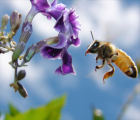Something D and I have wanted to do since purchasing our land is to have an Apiary (a beehive for the uninitiated). D did a beekeeping course a while ago and I’ve always thought they were damn cute and I love honey. So we decided we would get a beehive and put one on the property.
We did a bit of reasearch on the various kinds of beehives there are. There is the classic Langstroth beehive, which is the standard box beehive you see everywhere. There are top bar hives, these look like a log on their side cut in half. After much reading we settled on a “Warre Hive”. This is a hive design developed in France by Emile Warré. After studying many beehive styles he settled on this design as the most efficient and easiest on the bees.
With traditional hives honey is harvested by removing frames, these may be at any partof the hive and often there is a “queen excluder” that prevents the queen from entering certain parts of the hive so brood doesn’t get mixed with honey. This isn’t really a natural setup for bees as they prefer hollow logs and holes in trees. The warre hive attempts to mimic this by being a tall thin vertical hive, usually made of 3-4 boxes. Usually there are 3 boxes on the hive and a 4th standing by. Because bees build their comb from top to bottom the entire hive is made accessible. The bees initially place honey and lay eggs in the top box. But as the hive matures the bees build down into the second and third boxes. The queen prefers to lay near the middle or bottom of the hive as this is the warmest spot. So brood is moved down and eventually your top box contains nothing but honey.
Once you are ready to harvest you bring your empty box and lift the hive off the base. You then slide the empty box in the bottom, replace the hive on this and remove the top. You then take the top box and shake the bees from this into the lower boxes. You take the top box away and replace the roof. This box is your harvested honey and the brood grows down into the empty box. Rinse and repeat each season. Yummy honey.
Last month I purchased some wood from bunnings and made my own warre hive using the plans here : Warre Hive Construction Guide. I made some slight modifications to the plans because of the differences in Australian wood sizes (my boxes are slightly higher then the ones here) but it all worked out very easily. The hive came out nicely as you can see above. This was untreated pine and so in order to prepare it for being outside we had to coat it. Paint can be touch and go with hives because many chemicals can be toxic to bees. We decided to go with an safe mix of Organic linseed oil and mixed with melted beeswax. This gives the wood a nice slick coating that smells so good you want to eat it. (No kidding).
Now we’re just waiting till August when the weather is better and we’ll be taking it up onto the land to deploy it for delicious makings of honey. We’re on a waiting list for a starter hive (yes there is a waiting list) so hopefully we’ll get our bees soon. I’m so excited and can’t wait to report how it turns out. You can see a few interesting construction pics here : CONSTRUCTION.


